America’s bats are dying. A Michigan dam may hold a key to their survival
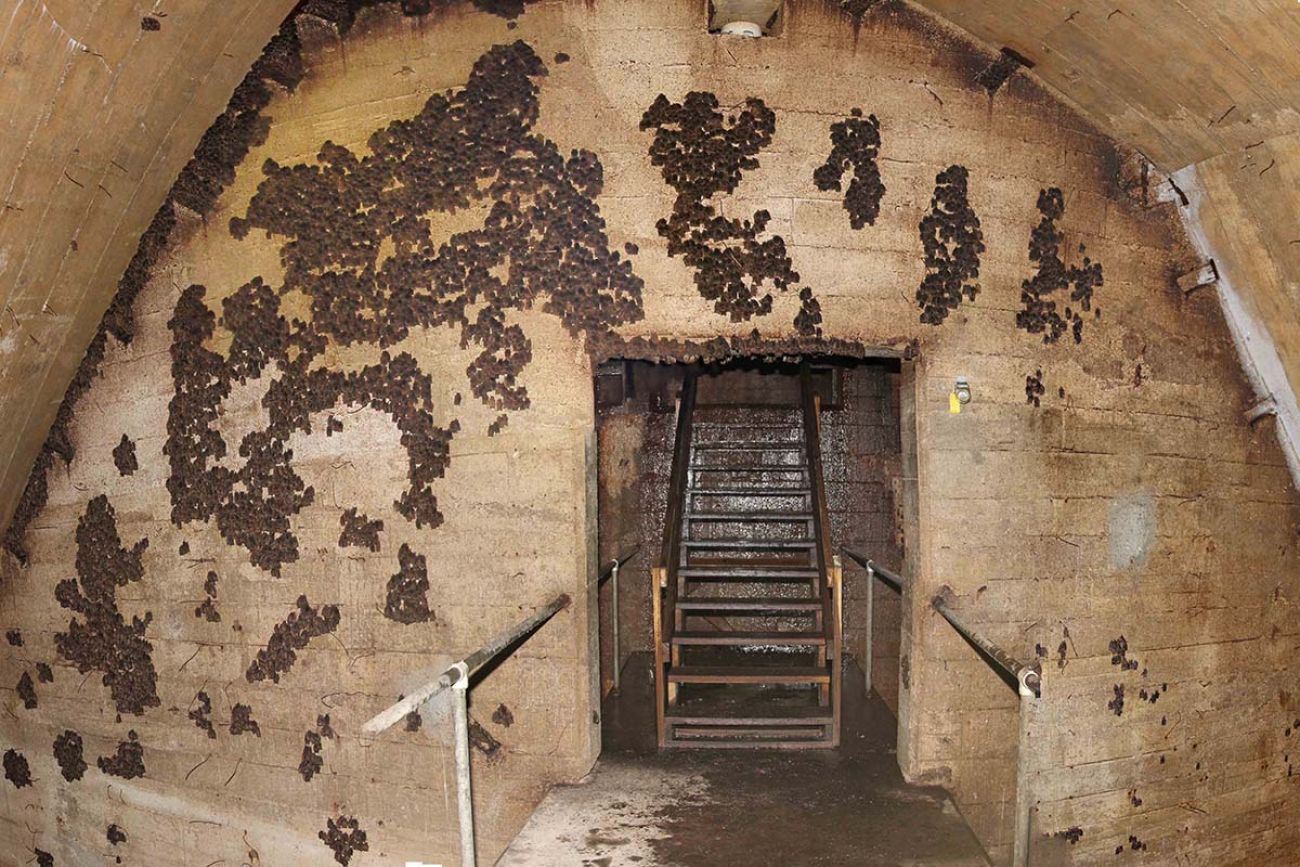
- Across North America, bats that hibernate underground are being wiped out by a deadly fungus
- But while other Michigan bats perish, more than 20,000 appear to be thriving inside a dam near Manistee
- Scientists are on a quest to figure out why
A deadly fungal disease is sweeping through the caves of North America, killing millions of bats as they hibernate.
From the caves of Kentucky to the abandoned mines of Michigan’s Upper Peninsula, winter dwellings once teeming with tens of thousands of bats are now nearly empty. The U.S. Fish and Wildlife Service has listed or is considering listing three species as endangered, while others face troubling declines.
But a glimmer of hope has emerged in an unlikely place: A Michigan hydroelectric dam.
Related:
- The deadly disease that wiped out 90% of the Upper Peninsula’s bats, and a new hope for one species
- Uncertainty for Michigan rivers, residents as Consumers reconsiders its 13 dams
- A rare butterfly makes last stand in Michigan. Feds have $57M plan to save it
“There is nothing like it at all,” said Scott Hicks, who leads the Fish and Wildlife Service office overseeing federal endangered species efforts in Michigan.
Inside the spillway of Tippy Dam, a century-old Consumers Energy impoundment in the Manistee River, tens of thousands of little brown bats (and a handful of other species) have coexisted with the deadly fungus for nearly a decade.

It’s unclear how these bats are surviving an epidemic that has devastated virtually every other exposed colony. Finding the answer has thrust the dam into the center of an international species recovery effort.
The Tippy Dam discovery
Under normal circumstances, Tippy Dam’s hollow concrete spillway would be a shabby place for a bat to roost.
Most hibernating bat species choose underground locations, like caves or the abandoned mines. They prefer to spend the winter in pitch-dark, tucked into rock crevices with a consistent temperature in the mid-40s.
Tippy fits none of those criteria: It has smooth concrete walls, ventilation holes that let light in, and a climate that mimics water temperatures in the Manistee River, swinging from 70 or more in the summer, to the high 50s when bats arrive in September, to near-freezing in midwinter.
So Allen Kurta, a world-renowned bat researcher at Eastern Michigan University, wasn’t expecting much when he heard a rumor in the early 1990s about “some bats in a dam.” He traveled to Tippy Dam, between Manistee and Cadillac, with a grad student hoping to find a few dozen.
Instead, there were more than 20,000 bats hibernating in the hollow concrete spillway, clinging to the walls of its 39-foot-high chambers. Most of them were little browns, a species that was then abundant in Michigan. There were also smaller percentages of the less-common northern long-eared, Indiana and tricolored bats.
Kurta figures the animals arrived at Tippy in a relatable way: They settled.
A lack of caves in the Lower Peninsula means a bat seeking better hibernation conditions would need to travel hundreds of miles to a U.P. mine or an Indiana cave.
“I always looked at it as the bat said, ‘Hell, I don't want to fly that far,’” Kurta said.
The oddly-placed colony became part of Kurta’s periodic population surveys of bat species across the state. Michigan’s colonies remained stable for decades, quietly doing what bats do: devour pests.
Using echolocation (an internal sonar) to hunt down moths, mayflies and other bugs, a voracious little brown bat can eat more than its weight in a single night. Their consumption of crop pests is worth more than $1 billion annually to corn farmers alone.
“Because we don't see them often, they’re definitely underappreciated in terms of their role in maintaining agricultural systems and forest health,” Hicks said.
And because insects are often disease vectors, it’s likely bats’ voracious appetites help limit the spread of illnesses.
So society had much to lose when a new illness began decimating bats in the mid-2000s.
A cold-loving killer
White-nose syndrome gets its name from the fuzzy white fungus that coats the skin of infected bats. The fungus that causes the syndrome, Pseudogymnoascus destructans, made its first U.S. appearance in the caverns adjoining a New York tourist cave in 2006.
That suggests humans introduced the disease. The fungus is also present in Europe and China, where bats appear to be adapted to its presence.
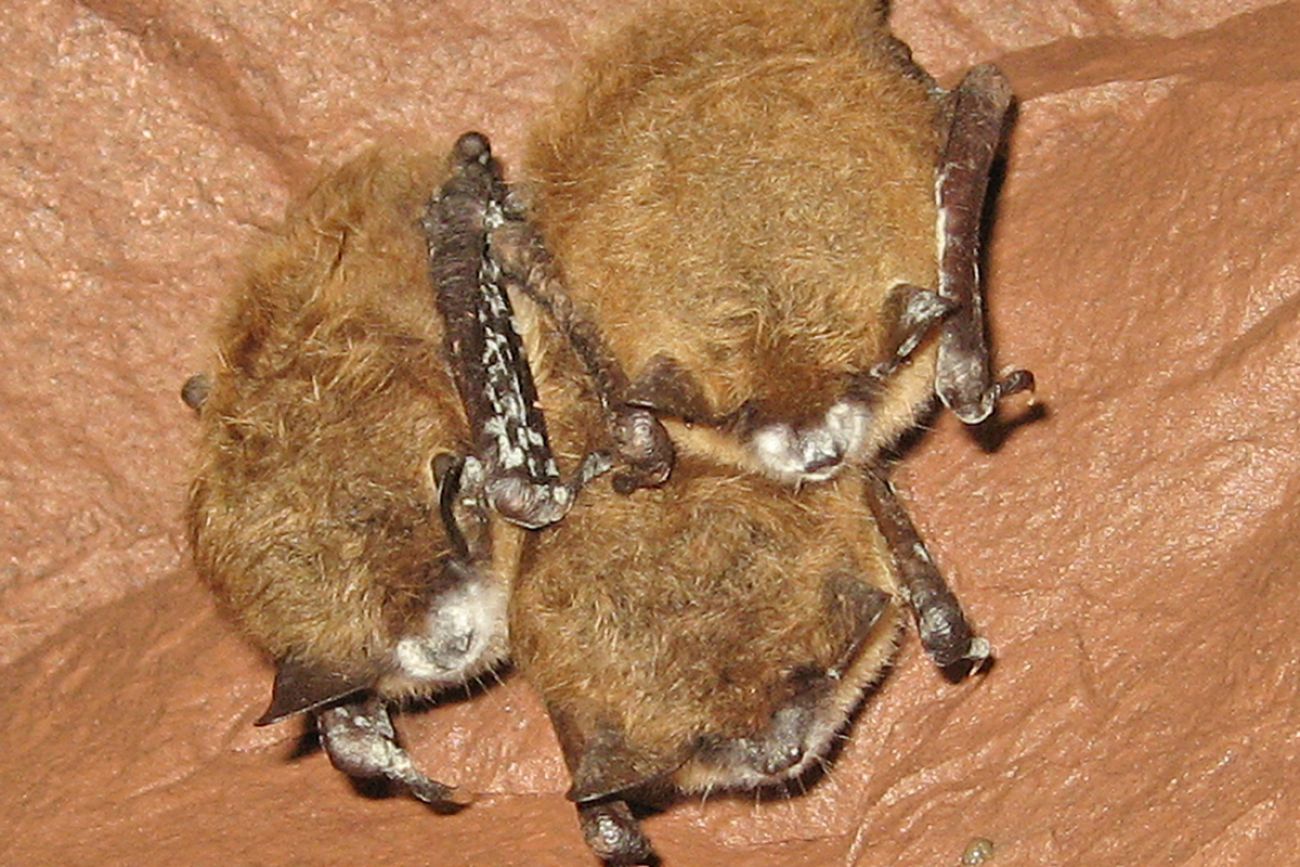
Bats infected with the Pseudogymnoascus destructans fungus can be identified by the fuzzy white powder on their nose and body. These bats inside the Mead Mine, in the Porcupine Mountains, are infected. (Photo courtesy of Allen Kurta)
By the time Kurta discovered Michigan’s first case in 2014, white-nose syndrome had killed 90 percent of eastern U.S. bats that hibernate underground.
It was able to do this by interrupting a key bat survival strategy: Their ability to shut down their metabolism to survive the winter.
When bats hibernate, their body temperature drops near that of the surrounding air. They stay this way for most of the winter, waking up for only a few hours every couple of weeks.
Like turning down the thermostat to save on heat, this allows bats to conserve their fat stores until spring. It also makes them susceptible to Pseudogymnoascus destructans, which only grows on surfaces colder than 68 degrees Fahrenheit.
“That’s why humans, cats, dogs, cows and horses don't have to worry about it,” Kurta said. “Because our skin is much warmer than 68 at all times.”
The fungus itself isn’t deadly. But it wakes the bats up more frequently, causing them to burn precious calories. They either starve to death in their hibernaculum, or fly out months too early in a doomed midwinter search for food.
Michigan’s most common cave-hibernating bats, the little brown and northern long-eared, are also the most susceptible. Their numbers have plummeted by more than 90 percent in infected areas.
Without a solution, both could disappear from Michigan.
And with only five states yet untouched by the fungus, “it's essentially going to be everywhere in the lower 48,” Hicks said.
Kurta, the EMU bat expert, shows his students a video from an Upper Peninsula mine during the early days of Michigan’s bat fungal infestation to help them understand the urgency of the situation.
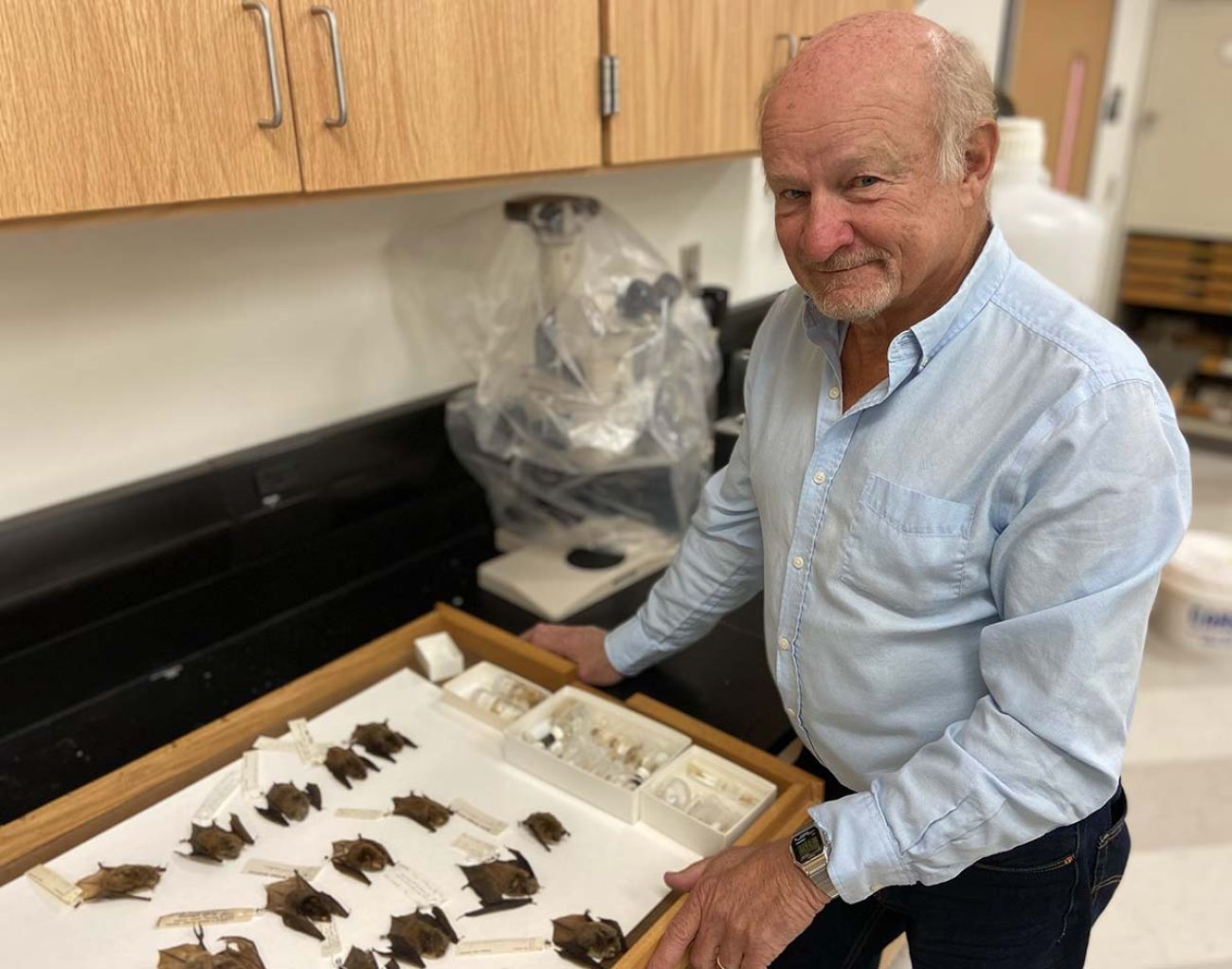
The inside of a healthy hibernaculum should be virtually motionless. Instead, the video shows bats flying about or writhing on the ceiling as they try to lick fungus from their skin. Some fall exhausted to the floor, where they drown in puddles or are eaten by rodents.
The U.S. Fish and Wildlife Service declared the northern long-eared bat to be endangered in November, in a decision agency director Martha Williams called “an alarm bell and a call to action.”
Meanwhile, the Indiana bat, listed as endangered throughout the eastern U.S. since the 1960s, is inching closer to extinction. Little browns are being evaluated for potential listing, and the tricolored could be listed this year. Experts are hopeful that some populations of little brown and tricolored bats will persist because their range extends into the southern U.S. and Latin America, where the cold-loving Pseudogymnoascus destructans can’t kill them as easily.
Policy changes, such as putting caves off-limits to human visitors, are of limited use, as white-nose continues to spread on the wings of the bats themselves.
That leaves scientific breakthroughs as the bats’ best hope.
The search for answers at Tippy Dam
After white-nose syndrome arrived in the U.P. mines, Kurta went back to Tippy Dam expecting to find similar carnage. Instead, a few northern long-eared bats had died, but tens of thousands of little browns appeared mostly unaffected.
Still, his heart sank. He assumed the fungus would soon take over.
“I firmly believed that the next time I came, they would have been all dead,” he said.
Instead, the bats have persisted year after year. Now, scientists are scrambling to understand why.
The first question, Kurta said: “Is it genetic, or environmental?”
In December, he collected 30 bats from inside the spillway and sent them to the National Wildlife Health Center in Madison, Wisconsin, along with 30 bats from a U.P. mine. Each has been swabbed with the fungus, then left to hibernate in a controlled environment.
If the Tippy bats fare better than their U.P. counterparts, they probably have a genetic resistance to white-nose syndrome, said Tonie Rocke, a research epidemiologist at the Wisconsin center.
If they die, something about the dam must be keeping them alive.
Given the emergency facing bats afflicted with white-nose, Rocke said, the wait for answers can be agonizing.
“You feel a lot of pressure sometimes to move faster,” Rocke said. But science is meticulous for a reason. “It’s important to confirm that what we might do will work, before we apply it haphazardly.”

If Rocke’s research rules out genetics, scientists have some promising theories about the dam itself. Ironically, the qualities once thought to make Tippy Dam a bad hibernating spot for bats could be helping to keep them alive.
Haley Gmutza, a former EMU grad student who now conducts PhD research at Ohio State University, theorizes the bats may benefit from the light that enters through the spillway’s ventilation holes.
In a darkened hibernaculum, bats lose track of time and their sleep-wake cycle gets out of whack. One may awaken at 2 a.m., while its neighbor snoozes until noon.
But in Tippy, light exposure keeps the bats on a 24-hour clock. Waking up in unison is less “energetically expensive,” Gmutza said, allowing bats to share body heat with their neighbors and burn less fat.
“It’s possible that this arousal synchrony is mitigating the energy costs of white-nose,” Gmutza said.
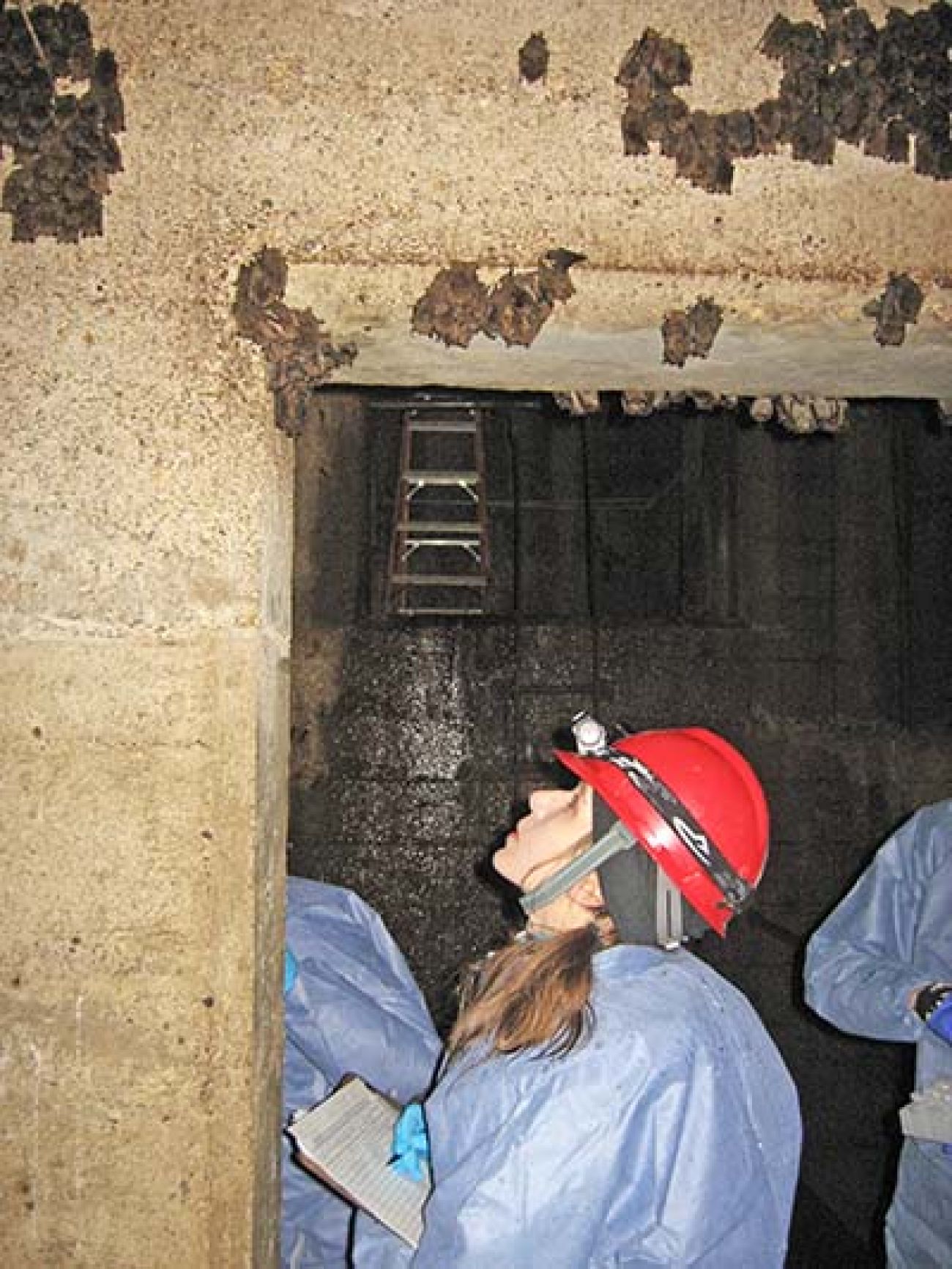
She doubts that’s the only thing keeping Tippy’s bats alive. But if it’s part of the equation, humans may be able to help other bats withstand the fungus by placing dim light sources in their caverns.
“It’s a ray of hope,” Gmutza said. “Whenever you talk about white-nose, it’s just like everything is bad. This colony had died out. This mitigation method didn’t work. It’s a parade of bad news. But Tippy is not.”
There are other possibilities yet to be studied, they include:
- That bacteria on Tippy bats’ skin differs from the bats in U.P. mines. Maybe that provides a defense against infection
- That the warm summers and frigid winters inside Tippy inhibit fungal growth
- That perhaps fungal spores are washed away in the summer when Consumers tests the dam’s spillway, a process that flushes water through the hollow inside
- Or maybe that the fungus simply doesn’t grow well on concrete surfaces
Hicks, of the Fish and Wildlife Service, called the effort to unlock Tippy Dam’s secrets perhaps “the single most important thing we could do to affect bat conservation,” particularly in places like Michigan.
Though lessons learned from Tippy have the potential to help bats across the continent, Hicks noted that the Upper Peninsula’s human-made mines could be more easily retrofitted with bat-protecting technologies than the inside of caves.
Time is of the essence: Annual surveys in the U.P. are detecting fewer and fewer of the affected bat species.
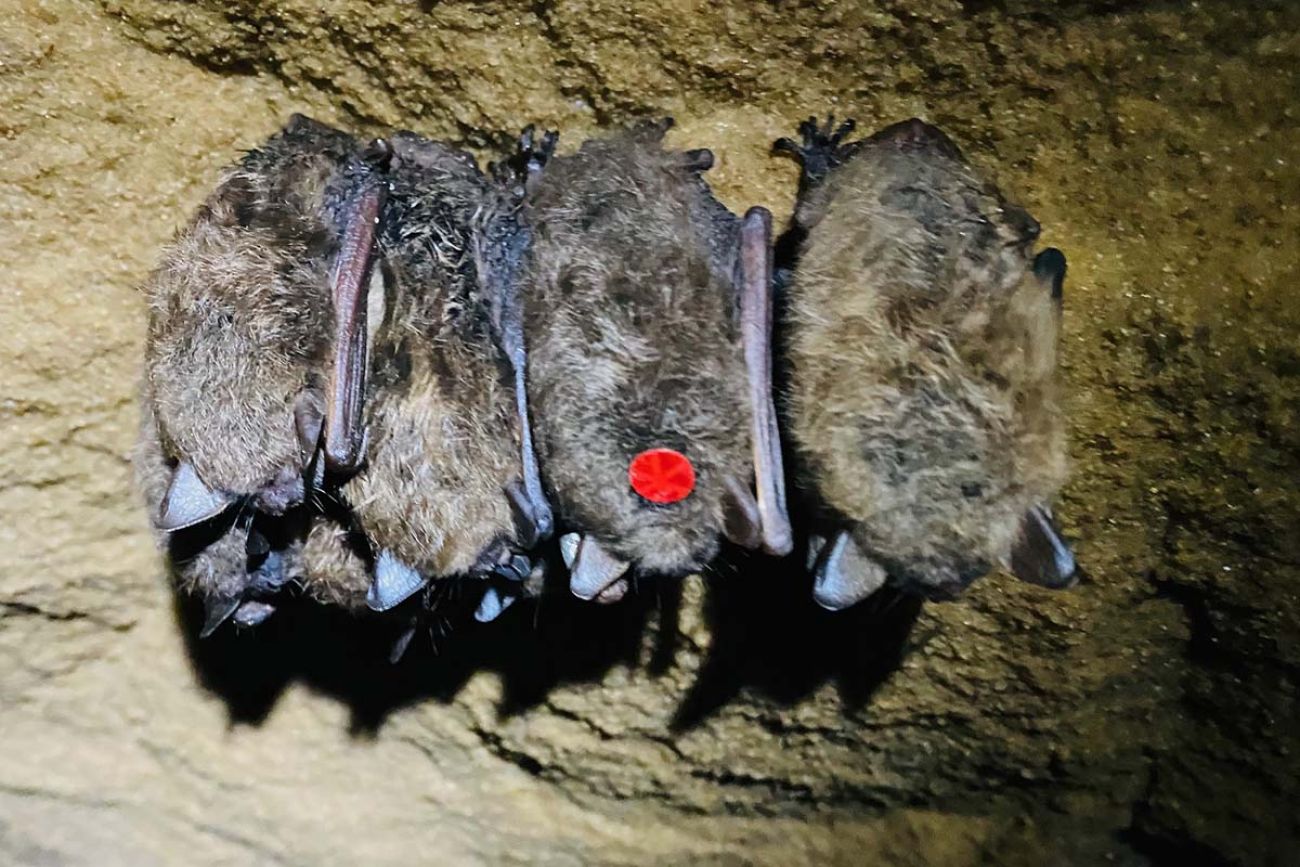
Kyle Seppanen, a wildlife coordinator for the U.P.’s Keweenaw Bay Indian Community, uses ultrasonic acoustic microphones to search for bats overhead each summer. Last year, he detected only 9 little browns.
Meanwhile, he is fielding more complaints from residents about out-of-control bugs.
In an area notorious for its thick clouds of mosquitoes and black flies, he said, the decline of bats is “one less thing that we have to fight insects in our area without people having to use pesticides and insecticides.”
While Michigan researchers search for answers at Tippy, their counterparts elsewhere are developing additional weapons against the disease. More than 150 nonprofits, tribes, government agencies and educational institutions are involved in the effort.
Rocke is testing a vaccine that has shown some promise during lab and field trials. Another option involves spraying polyethylene glycol, a petroleum-based compound found in laxatives and wood preservatives, on the insides of mines to stop fungal growth. And some scientists are using UV lights to attract insects to little brown bat hibernating spots, creating “bat buffets” designed to fatten bats up to better withstand infection.
And the few bats that survived the devastation in Michigan mines and eastern caves appear to be tolerating the fungus, sparking hope they may have genetic resistance.
Kurta noted that even if scientists are able to identify ways to combat the fungus, it will be difficult to deploy those methods widely enough to bring bats back from the brink. For instance, spraying cave walls with chemicals would be costly, logistically-challenging, and possibly hazardous to other species.
“These things work, and I think they can work on a small scale and prevent extinction,” Kurta said. “But they’re not the magic bullet that’s going to end the epidemic.”
That reality makes the Tippy colony’s persistence all-the-more remarkable.
Kurta last visited in February, counting about 26,000 healthy little brown bats. But he worries it could soon be too late for the northern long-eared bat; he hasn’t seen one in the dam since 2017.
It’s unclear what would happen to America’s farms and forests if species affected by white-nose syndrome disappear. Other bat species unaffected by the disease may help fill the void. Or humans may rely more heavily on chemicals to combat pests.
Beyond the benefits bats provide humans, Kurta sees a deeper meaning behind the massive effort to save them.
He rattles off astonishing facts about the world’s only flying mammals. They are among just a handful that use echolocation: sending out sound waves to find nearby prey. They are extremely long-lived (a little brown can live upwards of 30 years). And proportionately, they give birth to the largest newborns of any mammal.
“It’s just the fact that bats are such neat creatures in the world,” Kurta said. “And it would be very, very sad to see them go.”
Michigan Environment Watch
Michigan Environment Watch examines how public policy, industry, and other factors interact with the state’s trove of natural resources.
- See full coverage
- Subscribe
- Share tips and questions with Bridge environment reporter Kelly House
Michigan Environment Watch is made possible by generous financial support from:
Our generous Environment Watch underwriters encourage Bridge Michigan readers to also support civic journalism by becoming Bridge members. Please consider joining today.
See what new members are saying about why they donated to Bridge Michigan:
- “In order for this information to be accurate and unbiased it must be underwritten by its readers, not by special interests.” - Larry S.
- “Not many other media sources report on the topics Bridge does.” - Susan B.
- “Your journalism is outstanding and rare these days.” - Mark S.
If you want to ensure the future of nonpartisan, nonprofit Michigan journalism, please become a member today. You, too, will be asked why you donated and maybe we'll feature your quote next time!






